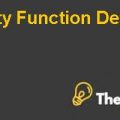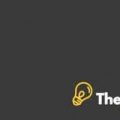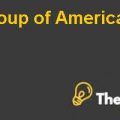Southwest Airlines Case Study Solution
Financial Analysis
Data given in the Exhibit 2 and 3 can be used to analyze the financial performance of the company. The overall financial performance of the company for the given years can be analyzed by using ratio analysis.
On the basis of given data in Exhibit 2 and 3 various profitability ratios and liquidity ratios are given in the Appendix 1. It could be seen from Appendix 1 that the return on asset and return on equity of the Southwest Airlines is highest in 1991 and after declining till 2005, it is again on a growing trend. It shows that the company had an efficient financial performance during 1990s, however, its financial performance started declining after 1990s. The operating margin and the net margin is also high in the year 1991. However, unlikely to its ROE and ROA, its operating margin is again at a declining trend, which shows that the company should manage its operating expenses to gain sustainable profitability growth.
Along with it, the liquidity and solvency ratios i.e. Current ratio, Debt Ratio, Debt to Equity Ratio shows that however the company has low debt ratio and debt to equity ratio in all the years, showing the solvency of the company, but the current ratio of Southwest is less than 1, which means the company has inefficient liquidity position, with its currents assets less than its current liabilities.
The financial performance of Southwest airlines can be analyzed by analyzing the impact of fuel hedging on the value of the firm. The data related to the fuel hedging is given in the Exhibit 5. The fuel hedging has substantial impact on the financial performance of the company as it enables the company to project the profitability and the cash flows, along with its, it reduces the fuel expenses which is one of the major portions of the operating expenses.
Exhibit 5 contains the pretax gain/losses on derivative instruments for the fiscal year 2006 and 2007. The gains from a hedging option are given with a negative sign, however, the losses are given with a positive sign. It could be seen from Exhibit 5 that the fuel hedge gains including fuel and oil expenses are increasing from $634 in 2006 to $686 in 2007. Along with it, the net premium cost of the fuel contacts is also increasing from $52 in 2006 to $58 in 2007.
Along with the pretax gain/loss on the fuel contract, Exhibit 5 also shows the data related to the fair value of the current fuel contracts of the company in 2007. The fair value of fuel contracts less than 1 year and above 1 year equals to $1069 $1318 million respectively. The net unrealized gains from fuel hedges equals to $1220. It shows that the fuel hedge contracts are one of the key measures to reduce the operational expenditures of Southwest Airlines.
Operational Performance Analysis
The operational management could be evaluated using the data given in the Exhibit 6a and 6 b. Exhibit 6a contains the data related to the operations at the Philadelphia International Airport from 2003 to 2008. It could be seen that the delay in the flight departures and arrivals is at a constant level from 2003 to 2008, showing that the company has not improved its flight timings. About 1/4th of the company flights are not on time, this could reduce the customer value for the Southwest Flights. Along with it, the average delay time is also not improving with the average delay time of about 1 hour. Moreover, no. of cancelled flights are also frequent at the airport with an average of 2% flights cancelled every year. The number of flights at the Philadelphia Airport are also declining. This could be due to the non-improving flight timings and the cancellation. The data shows that the overall operational performance of Philadelphia International Airport is not effective.
The data related to New York City La Guardia Airport from 2004 to 2008 given in the Exhibit 6b could be used to analyze the performance of the La Guardia Airport and compare it with the performance of Philadelphia Airport. It could be seen that, although, there is no huge difference between the data of two airports, however, the overall performance of La Guardia Airport seems better than the Philadelphia International Airport in terms of number of flights i.e. 119 in 2008 as compare to 100 in 2008 at Philadelphia.
Evaluation of Acquisition
The acquisition of gates and slots at the La Guardia airport can be evaluated on the basis of qualitative and quantitative analysis. The quantitative analysis of the acquisition plan can be done by using cash flow analysis. As the acquisition would increase the total number of flights at the airport, therefore the revenues are considered to grow at a 5% rate. The cash flows calculated on the basis of given data and certain assumptions shows that the acquisition would provide an increase in the total value of the firm by $226906, as the project has an NPV o $226906. On the basis of the positive NPV, the firm should acquire gates and slots.
However, he concerns of management over the number of flight delays and the declining operational performance etc. should also be considered. Although, the number of increasing flight delays and delay time would result in declining customer value at La Guardia Airport, but all these factors are quite controllable and the management at La Guardia Airport should control its operational management to avoid these delays rather than dropping a valuable acquisition program.
Conclusion
Southwest Airlines is facing acute challenges in terms of competition, operational management, financial performance etc. even after its major strategic shift. These challenges could be faced by acquiring operational efficiency and introducing customer value services at Southwest Airlines Airports. The plan for acquiring gates and slots for its La Guardia Airport could prove beneficial for the company in increasing its total number of flights at La Guardia by improving the customer services at the airport. Although, this would result in the shift of company’s cultural values and could increase the number of delays and the total delay time, but as the plan would increase the total value of the firm, therefore, the company should acquire gates and slots.
Appendices
Appendix-1: Ratio Analysis
| Ratio Analysis | |||||
| Profitability Ratios | |||||
| 1991 | 2001 | 2003 | 2005 | 2007 | |
| ROA | 8.80% | 5.90% | 4.00% | 3.80% | 4.30% |
| ROE | 17.30% | 12.40% | 7.90% | 7.90% | 9.60% |
| Operating Margin | 15.50% | 9.70% | 6.40% | 9.60% | 8% |
| Net Margin | 9.40% | 8.10% | 6.30% | 6.40% | 6.50% |
| Liquidity& Solvency Ratios | |||||
| 1991 | 2001 | 2003 | 2005 | 2007 | |
| Current Ratio | 0.65729167 | 1.125502 | 1.342426 | 0.940748 | 0.918355 |
| Debt Ratio | 33% | 30% | 31% | 53% | 30% |
| Debt to Equity Ratio | 0.65444288 | 0.683607 | 0.614212 | 1.130037 | 0.719349 |
This is just a sample partical work. Please place the order on the website to get your own originally done case solution.











